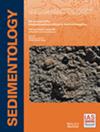Evolution from shallow-water deltas to fluvial fans in lacustrine basins: A case study from the Middle Jurassic Shaximiao Formation in the central Sichuan Basin, China
IF 2.8
2区 地球科学
Q1 GEOLOGY
引用次数: 0
Abstract
Distinguishing between shallow-water delta and fluvial fan deposits in the subsurface of lacustrine basins is challenging due to their similar depositional characteristics and distribution patterns. This study focuses on the Middle Jurassic Shaximiao Formation in the central Sichuan Basin using core observations, seismic analyses, petrology analyses, zircon analyses, palaeoclimate indicators and palaeocurrent analyses to address this issue. Fifteen sedimentary lithofacies and eight lithofacies associations were established, corresponding to channelized fluvial deposits, non-channelized fluvial deposits and shallow-water delta deposits. Shallow-water deltas are dominated by channels and mouth-bar complexes with grey, red and green interbedded mudstone. Shingled seismic reflection, green mud clasts, small burrows and wave ripples are common with occasional palaeosols. Fluvial fans are dominated by channels and crevasse-splays with pink colour and accompanied by red coloured floodplain deposits. Bright spot seismic reflection, red mud clasts, big burrows, current ripples and palaeosols are common. The increased uplift of the Dabashan Mountains controls the palaeocurrent direction, promoting the evolution from a shallow-water delta in relatively humid environments to a fluvial fan in relatively arid environments. The channel widths in shallow-water deltas are wider than those in fluvial fans, whereas the opposite applies for the channel amalgamation rate. Highly frequent channel-width variations are controlled by short-cycle climate fluctuation, corresponding to chemical index of alteration value fluctuations in different sandstone groups. The channel width in the relatively humid environments is wider than those in arid environments for both shallow-water deltas and fluvial fans. It is likely that the sedimentary evolution from shallow-water deltas to fluvial fans is relatively common in lacustrine basins in relatively arid environments with wide and gentle slope landforms.湖相盆地从浅水三角洲到河流扇的演化——以四川盆地中部中侏罗统沙溪庙组为例
浅水三角洲沉积与河流扇沉积具有相似的沉积特征和分布模式,区分二者具有一定的挑战性。本文以川中地区中侏罗统沙溪庙组为研究对象,通过岩心观测、地震分析、岩石学分析、锆石分析、古气候指标和古海流分析等方法,探讨了这一问题。建立了15个沉积岩相和8个岩相组合,分别对应河道化河流沉积、非河道化河流沉积和浅水三角洲沉积。浅水三角洲以河道和河口坝复合体为主,泥岩呈灰色、红色和绿色互层。瓦状地震反射、绿色泥屑、小洞穴和波浪波纹在偶尔出现的古土壤中很常见。河流扇以粉红色的河道和裂隙扇为主,并伴有红色的洪泛平原沉积。亮点地震反射、红泥碎屑、大洞穴、水流波纹和古土壤是常见的。大巴山隆升幅度的增大控制了古水流方向,促使其由相对湿润环境下的浅水三角洲向相对干旱环境下的河流扇演化。浅水三角洲河道宽度大于河流扇河道宽度,河道合并率则相反。频繁的河道宽度变化受短周期气候波动控制,与不同砂岩组蚀变值波动的化学指标相对应。无论是浅水三角洲还是河流扇,相对湿润环境下的河道宽度都比干旱环境下的河道宽度大。从浅水三角洲到河流扇的沉积演化可能在相对干旱、地形宽阔、坡度平缓的湖泊盆地中较为普遍。
本文章由计算机程序翻译,如有差异,请以英文原文为准。
求助全文
约1分钟内获得全文
求助全文
来源期刊

Sedimentology
地学-地质学
CiteScore
8.20
自引率
11.40%
发文量
94
审稿时长
6-12 weeks
期刊介绍:
The international leader in its field, Sedimentology publishes ground-breaking research from across the spectrum of sedimentology, sedimentary geology and sedimentary geochemistry.
Areas covered include: experimental and theoretical grain transport; sediment fluxes; modern and ancient sedimentary environments; sequence stratigraphy sediment-organism interaction; palaeosoils; diagenesis; stable isotope geochemistry; environmental sedimentology
 求助内容:
求助内容: 应助结果提醒方式:
应助结果提醒方式:


